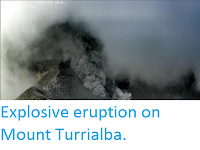Mount Turrialba in central Costa Rica came back to life on Wednesday 28 December, having been inactive since the middle of the month. Since then the University of Costa Rica’s National Seismological Network has detected more or less constant seismic activity (tremors) below the volcano combined with a series of small (and not so small) eruptions, including large events at 11.00 pm on Thursday 29 December and 3.35 and 8.00 am on Friday 30 December, the largest of these producing an ash column that rose 300 m above the summit of the mountain.
Eruption on Mount Turrialba on Friday 30 December 2016. Red Sismológica Nacional/Universidad de Costa Rica.
Turrialba forms part of the Cordillera Central, a range of volcanic mountains running through central Costa Rica and forming part of the Central American Arc. These volcanoes are fuelled by the subduction of the Cocos Plate, which underlies part of the east Pacific Ocean, beneath the Caribbean Plate, on which Central America lies, along the Middle American Trench, which lies off the south coast of the country. As the Cocos Plate is subducted it is gradually melted by the heat and pressure of the Earth's interior, with some more volatile minerals rising through the overlying Caribbean Plate as volcanic magma.
Diagram showing the passage of the Cocos Plate beneath Costa Rica (not to scale). Carleton College.
See also...








